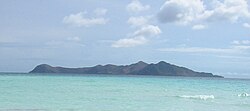Cuyo, Palawan
| Cuyo | ||
|---|---|---|
| Municipality | ||

Manamoc Island
|
||
|
||
 Map of Palawan with Cuyo highlighted |
||
| Location within the Philippines | ||
| Coordinates: 10°51′N 121°01′E / 10.850°N 121.017°ECoordinates: 10°51′N 121°01′E / 10.850°N 121.017°E | ||
| Country | Philippines | |
| Region | MIMAROPA (Region IV-B) | |
| Province | Palawan | |
| District | 1st district | |
| Barangays | 17 | |
| Government | ||
| • Mayor | Andrew L. Ong | |
| Area | ||
| • Total | 84.95 km2 (32.80 sq mi) | |
| Population (2010) | ||
| • Total | 21,847 | |
| • Density | 260/km2 (670/sq mi) | |
| Time zone | PST (UTC+8) | |
| Zip Code | 5318 | |
| IDD : area code | 48 | |
Cuyo is a fourth class municipality in the province of Palawan, Philippines. According to the 2010 census, it has a population of 21,847 people. Its territory includes the western half of Cuyo Island, as well as Bisucay, Caponayan, Cauayan, Imalaguan, Lubid, Manamoc, Pamalican, Pandan, Round, and Quiminatin islands, all part of the Cuyo Archipelago.
Cuyo is the oldest town in Palawan which has a culture of its own and was preserved for more than 350 years. During the Spanish colonization of the Philippines, Cuyo became the second capital of Palawan from 1873 to 1903.
From the sea, Cuyo Island's first visible landmark is a lighthouse by the pier. Many of the streets leading to the town have already been cemented but the town has preserved the Hispanic plaza-iglesia structures. Dominating the town centre is Cuyo's 1860 church, convent, and fort built by the Spanish and finished in 1680. Nearby stands a schoolhouse, and a monument of national hero Jose Rizal.
The municipality is served by Cuyo Airport in the neighboring municipality of Magsaysay.
Cuyo Island is the largest island of the Cuyo Archipelago, about 13 kilometres (8.1 mi) long, 7.5 kilometres (4.7 mi) wide, and with an area of 57 square kilometres (22 sq mi). It is under the jurisdiction of the municipalities of Cuyo and Magsaysay. The poblacion of Cuyo is home to a Spanish fort, which shelters a church and a convent in its high stone walls..
Cuyo is politically subdivided into 17 barangays. In 1956, sitio Danawan was elevated into a barrio.
Chinese traders were the first to discover Cuyo Island and introduced the trade and barter system in the locality.
Later, the Malay chief Matuod and his people arrived in big boats called sakayan and formed settlements on Cuyo. The Islamic chieftain Datu Magbanua later also settled on Cuyo, later consolidating his power so that chieftains from other islands recognized his rule. The Malays brought with them their dances, and when blended with native dance, the "Soriano", it became known as the "pondo-pondo" one of the most popular folk dances even up to the present.
...
Wikipedia


